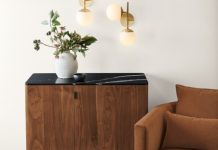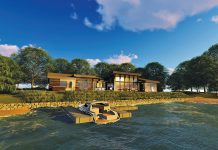
Lake Minnetonka is a vast, sparkling blue sapphire in Minnesota’s prized collection of jewels. With more than 150 years of rich, colorful history, the libraries, museums, and historical societies around the lake are filled with tales of the fur traders, soldiers, pioneers, and empire builders who left their indelible mark on the landscape.
As we began studying the boathouses of Lake Minnetonka, we discovered a tribe of courageous women who helped shape this remarkable corner of the world. As we talked to the owners of the boathouses, they introduced us to their plucky ancestors, including Sarah Chowen Shaver, the first white woman to settle on the lake in 1852, and her sister Susan Chowen Gray of Gray’s Bay fame. We met Olive Huhn, a feisty woman who rowed around Excelsior Bay in starched white linen dresses in the early 1900s, and Grace Lindley, an Olympic ski racer who became the first woman to water ski on Lake Minnetonka.
We also discovered the many Lake Minnetonka women whose names are forever etched in gold on vintage wooden boats. We learned about the Gerry Lo, a 30-foot runabout named after Geraldine and Lois Mary Griswold, daughters of Frank Griswold, and the Florence III, a wooden cabin cruiser named for Florence Smaby, wife of Martin Smaby.
Back in the day, these prized wooden boats cost thousands of dollars, many times the price of a car. Because the boats were imbued with so much financial and emotional value, the owners commissioned top architects such as Carl F. Struck and Harry Wild Jones to build elaborate boathouses to protect their investments. Designed to match their owners’ palatial villas, elegant summer homes, and sprawling lake cottages, the boathouses were often built in layers.
Depending on the owner’s wealth and lifestyle, the first level was either “wet,” allowing the boat to rest in or above the water on rails, or “dry,” with a floor that protected the boat from the water and provided space for storage and changing rooms. The second and third levels, often topped with gazebos, cupolas and belvederes, were used for camping out on summer evenings, entertaining family and friends, watching sailboat races, and enjoying spectacular views of Lake Minnetonka.
As we explored Lake Minnetonka’s many bays, we met warm, wonderful people who generously shared their memories and invited us to photograph their boathouses. Thanks to their hospitality, we strolled the grounds of summer cottages built by Civil War generals, grand waterfront estates that belonged to James J. Hill’s cronies, and other remarkable properties. On one memorable afternoon, we were invited to walk through a long narrow tunnel that ran between a boathouse and the main house, likely used for storing liquor during Prohibition.
We especially loved exploring the site of the former Bon Ami Club on Casco Point, where ghosts of wealthy southerners, St. Paulites, and steamship captains still linger in the trees. We even found enough facts to identify the architect of the famed “pagoda” boathouse on Smithtown Bay, solving a century-old mystery for the homeowners and the descendants of the original owners.
While countless old boathouses have disappeared into the mists of Lake Minnetonka, local boathouse expert Royal Dossett has counted 378 boathouses, gazebos, screen houses, pump houses, and other structures that still exist around the lake. Some have fallen into disrepair due to weather, neglect, and other forces, but many have been lovingly restored by their owners.
We discovered a handful of boathouses still owned by the original families, rustic boathouses filled with the smell of summer, brand-new boathouses designed by top architects, and other treasures. What follows is just a taste of the dozens of boathouses and other structures that we believe best represent the history—as well as the soul—of Lake Minnetonka.
Excerpted from Boathouses of Lake Minntonka, photographed by Karen Melvin, written by Melinda Melson, and published in April 2017 by Big Picture Press.
Robbins-Scott Boathouse

One of Lake Minnetonka’s most beloved landmarks, the iconic, three-story pagoda-style boathouse near Smithtown Bay was built for the Robbins family in 1916. It was likely designed by architect John Jager, with a mix of Japanese and Chinese influences. The property changed hands many times over the past 100 years. The current owners, Gregg and Lorraine Scott, purchased it in 1991 and have since restored and repainted every inch of the house and boathouse. Most recently, they designed the new, Asian-inspired moon door on the first floor facing the lake.
Smaby-Jeronimus Boathouse

In 1923, Martin and Florence Smaby built a new home on Priest Bay in romantic, Hollywood-meets-England storybook style, which was all the rage in the early 1920s. According to lake legend, the Smabys’ “retreat” room was one of two speakeasies on Highland Boulevard and a popular gathering place for politicians, VIPs, and A-list celebrities including the Andrews Sisters and Babe Ruth, and even the local police. To house their 40-foot-plus wooden cabin cruiser, the Smabys also built a boathouse of stucco and stone with a cedar shake roof and caretaker’s quarters with a pot-bellied stove at the back. The 60-foot, partially wet boathouse was—and remains—the longest boathouse on Lake Minnetonka. The restored boathouse now stores the Chris-Craft Custom wooden boat, Whoop, Whoop!, which belongs to current owners Deb and Jim Jeronimus.
Abbott Boathouse

The Abbotts believe their boathouse on Casco Point is at least 100 years old. They know their house was rebuilt on a 1934 foundation, the original structure swept away in the 1965 tornado that devastated much of the area. The graceful, three-story boathouse, with its Chinoiserie-style roof, is similar to other turn-of-the-century boat houses around the lake. The Abbotts love sitting and reading in the boathouse, and having friends over to watch the sunset from the upper deck. The rafter lights come on at twilight, illuminating the way for homeward-bound sailors and boaters on Spring Park Bay.
Grandview Boathouse

Situated at the end of a peninsula overlooking Carson Bay in Deephaven, Grandview Point once again boasts an eponymous boathouse. Originally part of a summer estate built in 1887, the property has changed hands and been subdivided since then. In 2008, the current owners commissioned architect Ben Nelson and builder Mark Warren to build a new house and restore the iconic boathouse. Warren rebuilt the walls and added a gas fireplace, white-painted beadboard paneling, and a custom-paneled ceiling. The interiors are furnished with rattan chairs, a comfortable hide-a-bed sofa, and a vintage-style shuffleboard game. The finishing touch: The original Grandview sign has been repainted in crisp black and white so it can be easily seen from the water.
Boulder Bridge Boathouse

Once owned by Nelson and Grace Dayton (he was the son of department store founder George Draper Dayton), this stone boathouse is part of the property known Boulder Bridge Farm. The stone boathouse, designed by Jackson M. Stone of J.M. Lyton Architects of Minneapolis in 1906, still stands, thanks to the massive boulders used in its construction. This boathouse, with the lift door drawn several feet above the water, is one of the few remaining wet-slip style boathouses on the lake. The pulleys, gears, netting, and lift door are all original equipment.
By Melinda Nelson. Photos by Karen Melvin




















